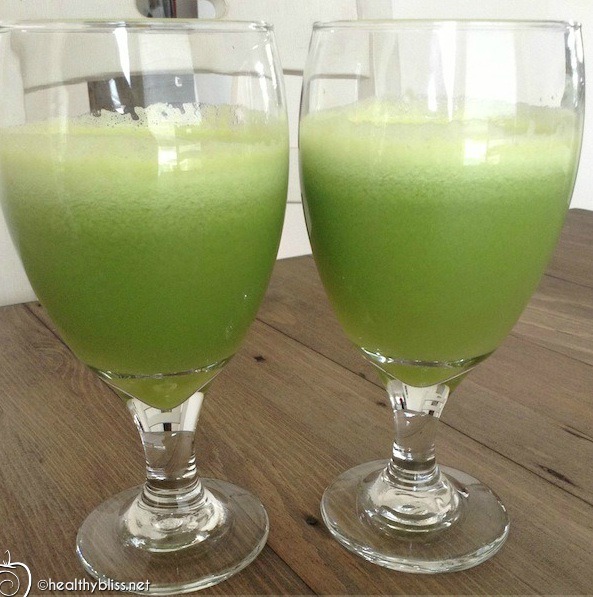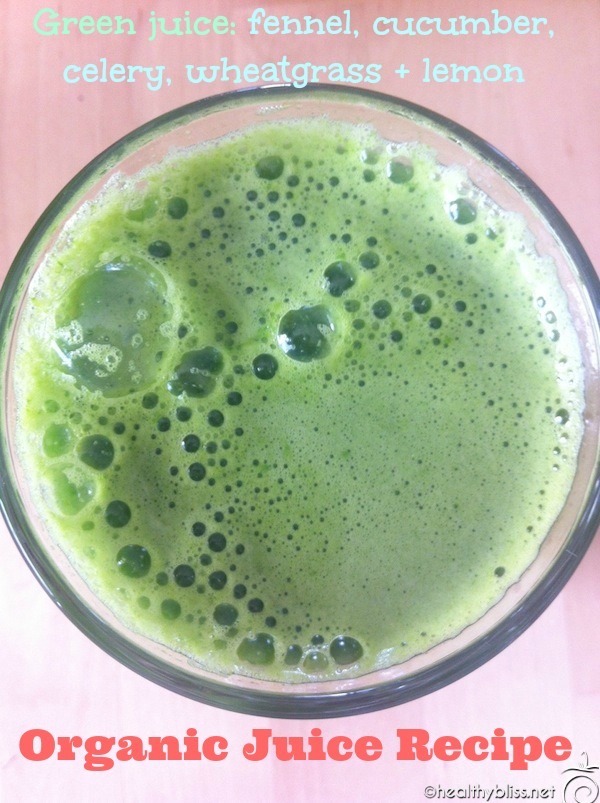Do you need to juice, and should you be juicing?
With all the hype about green smoothies for fitness, health and detox, you might be wondering: do I need to be drinking green juice or fresh juice too? And, if I only have time for one, which is better: blending or juicing?
All information in this article is for educational purposes only.
It is not for the diagnosis, treatment, prescription or cure of any disease or health condition.
I personally make a green juice for breakfast and a green smoothie for lunch every day and I love them both! But there are some real differences between blending a smoothie in a blender and making a juice in a juicer. Find out how and why below.

What are the health benefits of drinking fresh juice?
Juicing FAQs
Why is juicing important?
Juicing is important because it gives you the opportunity to high-boost on vitamins and minerals. In one meal, you wouldn’t normally have the capacity to eat ½ bunch celery, 10 carrots, 8 large kale leaves, an entire handful of parsley, 2 apples, a lemon, and a cucumber. Take all of those ingredients, put them in the juicer, and you’ve just ingested all the same nutrients in a few easy sips.
What are the pros/ benefits of juicing? Any cons (to one’s health and otherwise)?
The reality of living a busy lifestyle and not having time to prepare food at home today means that most people are not eating enough fresh fruits and vegetables and are therefore nutritionally deficient. Juicing is a way to combat this, and so that’s definitely a pro. The con is that it takes time to prepare and it’s takes even more time to clean the juicer. Most people don’t own a juicer, so it’s also an added expense to have to buy another appliance. For those reasons, I usually recommend blending smoothies in a blender. In a blender, the fiber remains intact and so you just drink everything. Blending is definitely more practical and easier to continue doing long-term. Any new habit has to be a healthy habit for life.
Who should juice? Why? Who, if anyone, should not?
Just to be clear on terms, juice is made in a juicer. The juicer separates the fiber from the liquid and leaves only a liquid to drink (the juice). If you take those same ingredients and put them in a blender, the fiber will remain intact and you will have a smoothie, which is thicker and more filling than a juice. Traditionally people think of a smoothie having milk or yogurt, but you can easily make a healthy smoothie with fruits, greens and 1 cup of water. You may have heard of ‘Green Smoothies’…well, that’s what it is: fruits and greens blended in a blender. I think everyone should have 1 Green Smoothie per day.
So, who should juice? Anyone who is sick is already nutritionally out of balance and most likely deficient. Ideally they should be high-boosting with nutrient dense foods to try to get the body back into balance, so a daily juice would be great for them. For diabetics, fresh fruit juices are usually too high in sugar and in that case, make only green juices instead, like cucumber, kale, lemon, ginger and parsley.

Take the time to make a green juice – it’s an investment in your health!
Is there a limit to how much juicing one should do? Is there such thing as excessive juicing?
I usually recommend adding fresh leafy greens (like celery greens or boy choy) to any fruit juice just to balance the natural sugars with the greens. People can do 100% juice fasts, ie drinking only freshly made juice, for up to 60 days at a time with no ill effects. For the average person, having 1 fresh juice or smoothie per day is a great addition to their daily diet. Think of getting your vitamins fresh from Mother Earth and not a pill!
Should juicing replace entire meals or be a supplement?
It really depends on the individual, their energy levels and their goals. The average person can have a green smoothie for breakfast as a meal replacement because the fiber in the smoothie keeps them from being hungry and it’s a great way to start the day with fiber, alkalinity and minerals and chlorophyll from the greens. I work one-on-one with my clients to determine the best meal plan for them.
Is juicing the same as detoxing? If so, are the terms interchangeable?
Juicing is not the same as detoxing. One glass of fresh apple, ginger, lemon juice is not going to put you into detox mode (although it will high-boost your mineral and vitamin reserve). The process of detoxification starts when the body has been eating light raw fresh fruits or drinking only fresh juice for at least 36 hours. If you continue drinking only juice at the 36-hour mark, then you are going into ‘detox,’ and that means your body starts using the enzymes it would normally use to digest food and directs the energy inward to internal housekeeping. Think of your organs having extra paperwork and a backlog of work on their desks. Suddenly, no more papers are coming in so everyone has a chance to catch up on their jobs. That’s detox. If you are eating refined sugar, bread, fried foods or drinking coffee and alcohol, you are still adding more work for those organs and no detox will occur.
When and How to Juice
Initially you may enjoy having fresh juice on the weekends when you have more time to prep the ingredients and clean the juicer. You may also find yourself making juice when you’re ill as a natural recovery remedy. On a daily basis, making a green smoothie is faster and easier, and because of that, you’re much more likely to keep doing it every day. This article covers the key points in making juice and what equipment you need. For more information on making fruit smoothies or green smoothies in a blender, go to this link.

Experiment with different fresh & organic ingredients in your juice
Making juice is more labor intensive and a bigger commitment in terms of time and money for a few reasons:
- You need a juicer. A juicer is a different appliance than a blender. It’s an added expense if you don’t have one already.
- You need more ingredients to make one 16-ounce juice than you do for a 16-ounce smoothie.
- You need to spend more money on the extra ingredients required. It takes time to cut up the extra ingredients too.
- Cleaning a juicer takes more time than cleaning a blender because a juicer has several parts (unlike a blender that just has a pitcher and a lid).
On average, it may take 6-8 minutes to clean your juicer in addition to 5-6 minutes of prep plus 2-3 minutes of juicing, for a total of at least 17 minutes to make a juice. Compare that to a 5-minute green smoothie and the difference really adds up!
How long does a juice stay fresh?
Without any fiber, juice oxidizes very quickly and that means you need to drink it immediately after making it. If not, the juice will start to go off and in just a few hours, it can go bad. This is a major difference between green smoothies and green juices.
Making a green juice
Besides cutting up some extra ingredients and cleaning a few additional parts of the juicer, it’s really not difficult at all to make a green juice. One thing that is important for green juices is the type of juicer you have. (Note: If you’re interested in juicing your own wheatgrass at home, you need a masticating juicer. The Omega 8004 juicer is a great model for making fresh green juice and wheatgrass juice. Other options include the Champion juicer and the Hurom vertical slow-press juicer.) I explain more on that in my article about Choosing a Juicer.

A green juice is a high-boost of minerals, vitamins and chlorophyll
Green juice recipes are very similar to smoothie recipes with just a few exceptions. The following are ingredients not to use in a juice:
- Banana, dates, nuts, seeds and avocado – Due to their high density, they don’t really have any liquid to juice.
- Superfood powders – You can add your favorite superfood powder, ground flaxseed or chia seeds to your glass of juice and stir just before drinking, but you don’t want to add it to the juicer. With powders, there’s nothing to juice!
Fruits and greens with high water content, like cucumber, orange, lemon, apple, pear, pineapple, watermelon and celery are great options for juice ingredients. You can also add carrot, beet, daikon, ginger, fennel or leek. My favorite greens to add to juice are parsley, cilantro, basil, kale, Swiss chard or collard greens. Organic fruits and greens are best, but do the best you can with what you have when starting out. A non-organic juice is still better for you than a frozen dinner or fast-food lunch!
Tip
Save the stems from your large green leaves like kale, spinach, Swiss chard or collard greens after making a green smoothie. Store them wrapped in a plastic bag in the fridge. When you’re ready to make a juice, add the stems to the juicer. That way, the stems don’t go to waste and you’re getting the added nutritional benefit of the minerals, vitamins and antioxidants from them in your juice.
For more on how to start a raw food diet, how to do a detox at home or what minerals you may specifically be deficient in, book a private health consult with me via Skype.
How to Book Your Health Coaching Session:
1. Take photos of your eyes with a digital camera.
2. Email the photos to me for approval.
3. We schedule a time to meet via phone or Skype!
More on Colon Cleansing:


Follow Jennifer